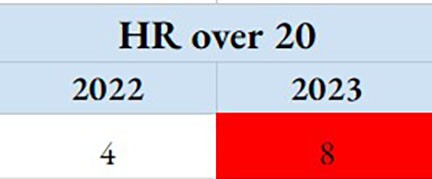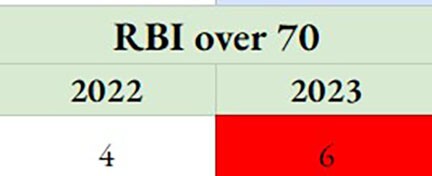Welcome to the second installment of our Fantasy Baseball State of the Union. Last week, we began looking back to see if this “new” version of the game we love had any meaningful impact in fantasy. Of course, some of the stuff you can already imagine, like the increase in stolen bases and the higher batting average without the shift, but what does that mean for each position? Did it create more value in certain spots? How does that impact our 2024 draft strategy? These are the questions I’m looking to answer in this State of the Fantasy Baseball Union series.
You can look at my examination of first base here, but today we are going to turn our attention to second base. I sorted by players who accumulated 200 plate appearances both this season and in 2022 and looked to see if there was any meaningful change in the standard 5x5 offensive categories (batting average, home runs, runs, RBI, and steals). Then I tried to dive into WHAT that change was, WHY it may have happened, and HOW likely it is that we see it again.
This is not quite the jump we saw at first base. In fact, first baseman who hit over .240 went from 29 in 2022 to 40 in 2023. Now, does that mean that first base is a better source of average than second base? Not likely; however, I do think it highlights a truth that you’ll see throughout this article, which is that second base is not a deep position for fantasy purposes.
There are some high-end batting average assets here like Jose Altuve, Luis Arraez, and Mookie Betts (who, yes, does qualify at 2B), and then some other typically solid batting average contributors like Ozzie Albies, Marcus Semien, Ketel Marte, Nico Hoerner, and even younger guys like Matt McLain and Bryson Stott. So, when it comes to batting average, there are still more than enough solid batting average assets at the second base position, and while we didn’t see a massive jump thanks to the new shift rules, we have always known second base to be a spot where we can get some average help with 24 players who had a meaningful number of at-bats hitting .260 or above in 2023.
What that tells me is that second base is a good spot to target for rostering a player who will provide some batting average buffer for your power-hitting outfield types. If you don’t get a second baseman who hits for a solid batting average, you might be putting yourself in a bit of a hole in this category.
This is where we run into issues. The red in the image above means that it’s the lowest total by position, so second base has the fewest players of any position that hit over 20 home runs. Yes, the position did see a boost from last year and full seasons from guys like McClain, Zack Gelof, and Edouard Julien could push this number higher, but you’re still not going to find many meaningful power contributors at the position.
In fact, only three second baseman hit over 20 home runs in each of the last two seasons: Jose Altuve, Marcus Semien, and Gleyber Torres. Ozzie Albies has hit over 20 home runs in every fully healthy season he’s played, so those four names are the only players at the position with consistent year-over-year power production. Again, you can believe any of those younger players will join the ranks of consistent 20-home run hitters but even that keeps the number at the position in single-digits.
What that means for us is, if we’d like a true five category contributor at second base, and we would, then it makes some sense to dip into the position early. Getting one of the four guys mentioned above or Mookie Betts could be a huge boost. There are some intriguing names later when it comes to power like McLain, Gelof, Ha-Seong Kim, and Nolan Gorman, but there is far less of a track record of success and far more risk associated with those selections.
Another category where second base produces the least value of any position. Only Albies, Betts, Semien, Marte, Gorman, and Brandon Drury had over 70 RBI this season. Although Arraez had 69 and all of Torres, Hoerner, and Brandon Lowe finished with 68 so there were a few on the periphery. Last year, Semien and Torres both had over 70 RBI, joined by Jake Cronenworth and Wilmer Flores (remember Jake Cronenworth?)
The takeaway here is pretty clearly that RBI value will be hard to come by at second base outside of the top tier names. You can certainly get some guys who will chip in 50-60 RBI on the season, but it’s just another indication that if you don’t grab one of the top names at the position, you’re making it far more likely that you get a player who contributes in just four, or more likely, three categories. While that’s fine because many of those players go later in drafts, it’s just a strategic component you need to weigh out.
If second basemen aren’t going to produce a lot of value in home runs and RBIs then we need to find other places for them to contribute. With many of the better options hitting near the top of the batting order, we get more consistent production in runs out of the second base spot.
As you can imagine, it’s more of the same names in the leaderboard here: Betts, Semien, Hoerner, Albies, Marte, Torres, Altuve, Arraez, and Stott. When factoring in runs, we also get Jonathan India, Jeff McNeil, Andrés Giménez, Ha-Seong Kim, and Mauricio Dubón. Matt McLain would also have been on here with a full season of action, as would Julien.
So what’s the takeaway here? For me, it seems that we can use the second base spot in order to get chip-in runs if we find ourselves in need of that category and while it’s the same guys at the top, we now have players like Stott and McNeil and (to a lesser extent Whit Merrifield and Thairo Estrada) who are plus contributors in both average and runs, which could be valuable for your team if you’re solid in other categories by the time you get to those later rounds.
As with every other position, we saw more players contributing meaningfully in stolen bases in 2023, which is a reality that we should meaningfully expect to stick around in the future thanks to the rule changes. While some of our top contributors in the categories above added some stolen base value many of them fell just under the arbitrary 15 steal cut-off: Betts, Altuve, Semien, India, McLain, and Gelof all finished with 14 steals (although, McLain and Gelof didn’t play a full season). We also had Albies and Torres with 13.
Which is a long-winded way of saying that Betts, Altuve, Semien, Albies, and Torres all have proven to be solid five-category contributors while McLain, Gelof, and Kim have the makings of growing into that role.
If we’re looking to prioritize speed at the middle infield positions, which we usually are, then Nico Hoerner emerges as a stud here. We also see Stott, Kim, Estrada, and Giménez show up again, creating a pretty consistent grouping of solid three category guys if we miss out on the top tier at the position.
So, to simplify, there’s a clear top group of five-category guys at second base with Betts, Altuve, Semien, Albies, Torres, McLain, and Gelof. Then there is a clear next grouping of three or four-category guys like Marte, Stott, Hoerner, and Estrada with Kim straddling the line between four-category and potential five-category player depending on his batting order slot and RBI upside.
As of now, below is my top-15 2B for 2024. Obviously a lot can change before the season kicks off, but this is where we’re at as of now.
Make sure to check back over the next couple of weeks as I go through all of the positions.















